
Rupprecht, Crown Prince of Bavaria, Duke of Bavaria, Franconia and in Swabia, Count Palatine by the Rhine, was the last heir apparent to the Bavarian throne. During the first half of World War I, he commanded the 6th Army on the Western Front. From August 1916, he commanded Army Group Rupprecht of Bavaria, which occupied the sector of the front opposite the British Expeditionary Force.
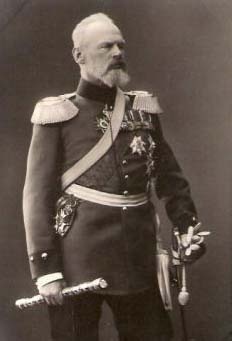
Prince Leopold of Bavaria was born in Munich, the second son of Prince Regent Luitpold of Bavaria (1821–1912) and his wife Archduchess Augusta of Austria (1825–1864). He was a Field Marshal (Generalfeldmarschall) who commanded German and Austro-Hungarian forces on the Eastern Front in World War I.

The Order of the Black Eagle was the highest order of chivalry in the Kingdom of Prussia. The order was founded on 17 January 1701 by Elector Friedrich III of Brandenburg. In his Dutch exile after World War I, deposed Emperor Wilhelm II continued to award the order to his family. He made his second wife, Princess Hermine Reuss of Greiz, a Lady in the Order of the Black Eagle.

The Order of the Red Eagle was an order of chivalry of the Kingdom of Prussia. It was awarded to both military personnel and civilians, to recognize valor in combat, excellence in military leadership, long and faithful service to the kingdom, or other achievements. As with most German other European orders, the Order of the Red Eagle could be awarded only to commissioned officers or civilians of approximately equivalent status. However, there was a medal of the order, which could be awarded to non-commissioned officers and enlisted men, lower ranking civil servants and other civilians.

The Order of the Redeemer, also known as the Order of the Saviour, is an order of merit of Greece. The Order of the Redeemer is the oldest and highest decoration awarded by the modern Greek state.
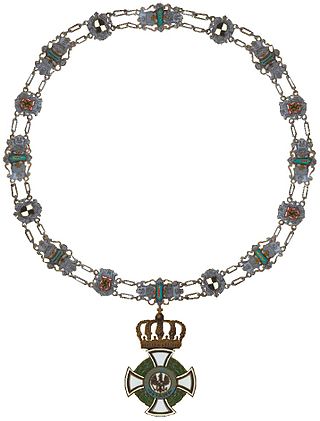
The House Order of Hohenzollern was a dynastic order of knighthood of the House of Hohenzollern awarded to military commissioned officers and civilians of comparable status. Associated with the various versions of the order were crosses and medals which could be awarded to lower-ranking soldiers and civilians.

The Military Merit Cross (Militärverdienstkreuz) was established by Friedrich Franz II, Grand Duke of Mecklenburg-Schwerin on August 5, 1848. Mecklenburg-Schwerin, a grand duchy located in northern Germany, was a member of the German Confederation and later the German Empire.
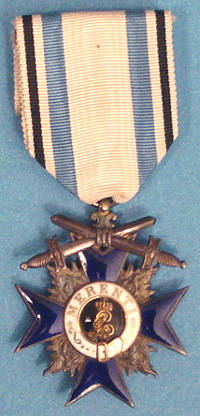
The Bavarian Military Merit Order was established on 19 July 1866 by King Ludwig II of Bavaria. It was the kingdom's main decoration for bravery and military merit for officers and higher-ranking officials. Civilians acting in support of the army were also made eligible for the decoration. The Military Merit Order ranked below the Military Order of Max Joseph (Militär-Max-Joseph-Orden), which was Bavaria's highest military honor for officers.

The House and Merit Order of Duke Peter Frederick Louis or proper German Oldenburg House and Merit Order of Duke Peter Frederick Louis was a civil and military order of the Grand Duchy of Oldenburg, a member state of the German Empire. The order was founded by Grand Duke Augustus of Oldenburg on 27 November 1838, to honor his father, Peter Frederick Louis of Oldenburg. It became obsolete in 1918 after the abdication of the last grand duke.

The Military Order of Max Joseph was the highest military order of the Kingdom of Bavaria. It was founded on 1 January 1806 by Maximilian I Joseph of Bavaria, the first king of Bavaria. The order came in three classes:
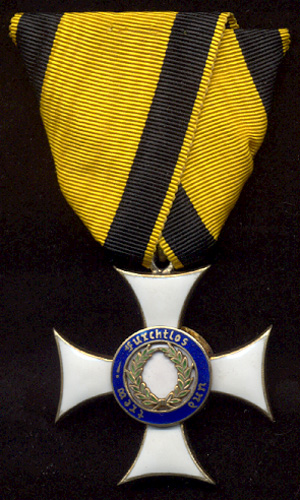
The Military Merit Order (Militärverdienstorden) was a military order of the Kingdom of Württemberg, which joined the German Empire in 1871. The order was one of the older military orders of the states of the German Empire. It was founded on 11 February 1759 by Karl Eugen, Duke of Württemberg as the Militär-Carls-Orden, and was renamed the Militärverdienstorden on 11 November 1806 by King Friedrich I. The order underwent several more revisions over the course of the 19th and early 20th centuries. It became obsolete with the fall of the Württemberg monarchy in the wake of Germany's defeat in World War I.

The Military Order of St. Henry was a military order of the Kingdom of Saxony, a member state of the German Empire. The order was the oldest military order of the states of the German Empire. It was founded on October 7, 1736 by Augustus III, King of Poland and Elector of Saxony. The order underwent several more revisions over the course of the 19th and early 20th centuries. It became obsolete with the fall of the Saxon monarchy in the wake of Germany's defeat in World War I.

The Frederickcross was instituted in 1914 by the ruling Duke of Anhalt, Frederick II of Anhalt as a decoration not unlike the Iron Cross for merit in time of war.

Dietrich Graf von Hülsen-Haeseler was an infantry general of the German Empire.

The Order of St Alexander was the second highest Bulgarian order during the Kingdom of Bulgaria. It was established by Knyaz Alexander I and named after his patron saint.

The Friedrich-August Cross was a German decoration of the First World War. It was set up on 24 September 1914 by Frederick Augustus II, Grand Duke of Oldenburg, with two classes, for "all persons of military or civilian status, who have shown outstanding service during the war itself".
The Brunswick War Merit Cross also known as the Ernst-Augustkreuz, was a military decoration of the Duchy of Brunswick. The Cross was established 23 October 1914 by Ernest Augustus, Duke of Brunswick. The cross was awarded to all ranks for distinction in war. On 20 March 1918, a first class of the Cross was created in pinback form, with the existing Cross becoming the second class. This brought the Cross in line with awards of other German States like Prussia with the Iron Cross. The cross was awarded on a blue ribbon with yellow stripes for combatants and on a yellow ribbon with blue stripes for non-combatants.
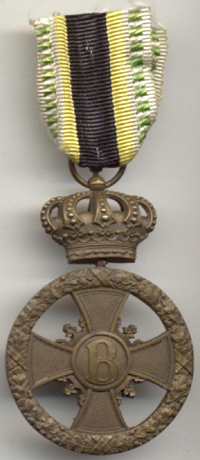
The Cross for Merit in War was a military decoration of the Duchy of Saxe-Meiningen established by Bernhard III, Duke of Saxe-Meiningen on 7 March 1915.

The House Order of Henry the Lion In German: Hausorden Heinrichs des Löwen, was the House Order of the Duchy of Brunswick. It was instituted by William VIII, Duke of Brunswick on 25 April 1834. The ribbon of the Order was red with yellow edges. It had five grades: Grand Cross, Grand Commander with Sash, Commander, Knight 1st Class, Knight 2nd Class, plus Medal of Merit for Science and Arts, the Cross of Merit and the Medal of Honour. The Order was named in honour of Henry the Lion, who remains a popular figure to this day.

The Düppel Storm Cross was a military medal of the Kingdom of Prussia. The cross was awarded to Prussian participants in the Battle of Dybbøl which took place on 18 April 1864, during the Second Schleswig War. Established by Wilhelm, King of Prussia on 18 October 1864, the cross was initially awarded to combatants and noncombatants who directly participated in the battle. The following year, versions were created for those troops held in reserve at the battle and members of the Johanniter Orden who participated in the battle.



















